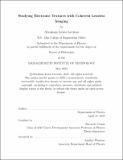Studying Electronic Textures with Coherent Lensless Imaging
Author(s)
Levitan, Abraham Lewis
DownloadThesis PDF (30.73Mb)
Advisor
Comin, Riccardo
Terms of use
Metadata
Show full item recordAbstract
X-ray microscopes have opened our collective eyes to the richness of nanoscale texture in systems such as correlated and quantum materials. These microscopes draw their power from the combination of short wavelengths, which provide high resolution, and interaction with atomic resonances, which makes them sensitive to subtle changes in electronic structure. However, x-ray microscopy remains an area where the main limits are technological rather than fundamental. Therefore, major progress is still possible with methodological improvements.
In the past twenty years, research has exploded into the use of coherent x-ray light to improve the quality and resolution of x-ray microscopes. In many cases, using coherent light makes it possible to remove the objective lens in a microscope, replacing it with an algorithmic analysis of the direct scattering data. This can increase the quality and resolution of the resulting quantitative images.
In this thesis, I present the results from a collection of projects aimed at using coherent imaging methods to study the real-space texture of electronic phases of matter with soft x-ray light. I first discuss the methods we developed and implemented to counteract the experimental errors that we found to be ubiquitous in our data, focusing on ptychography, the most commonly used lensless imaging method. Then, I turn to the development of an entirely new single-shot lensless imaging method, randomized probe imaging (RPI).
RPI has proven to be reliable and robust across a broad range of scenarios. The remainder of the thesis is devoted to applications of RPI at a free electron laser and a synchrotron. Also reported are further projects designed to improve the method, as well as attempts to expand our understanding of the mechanisms behind it and its limitations. I sincerely hope that the availability of RPI will help bring x-ray imaging to a broader group of scientists and lead to a better understanding of the nanoscale details of electronic texture.
Date issued
2023-06Department
Massachusetts Institute of Technology. Department of PhysicsPublisher
Massachusetts Institute of Technology